THE BFS STRAIGHT-LEG DEAD LIFTIs it Safe? Why Do it? What about the Knees?By Dr. Greg Shepard Published: Summer 2002 The BFS Straight-Leg Dead Lift is a high-priority auxiliary lift. We think of this lift as a stretching exercise. Therefore, our recommended technique is to use a very light weight and do every rep slowly, controlled and deep. Some have questioned the BFS position for the lower back and our technique of keeping the knees locked. This criticism could be justified if our primary purpose were to build strength. However, the BFS goal is to win, and a primary component of winning in school sports is speed. Improving hamstring flexibility is a key component in improving an athleteís speed. We know that our SLDL technique will make a measurable difference in cutting up to two-tenths of a second off a 40 time. Improving hamstring flexibility will also improve jumping ability. The following are our SLDL guidelines in using this great auxiliary lift to your advantage. How Much Weight? Junior high boys and girls should use 45 or less pounds. Most high school women athletes should use between 45 and 65 pounds. Very strong, mature women high school athletes could use up to a maximum of 95 pounds. High school male athletes should use up to 95 pounds. Very strong, mature male high school athletes could use up to a maximum of 135 pounds. College women athletes should use up to 95 pounds, while very strong, mature college women athletes could use up to 135 pounds. College male athletes should use between 95 and 135 pounds, while very strong, mature college athletes could use up to 185 pounds. The absolute max anyone should use is 40 percent of their parallel squat. Sets & Reps and Progression Do two sets of ten repetitions two times per week. Do not record this lift in the Set-Rep Logbook or the Record Card. Do not break records. Do not try to do a little more each week. Keep the poundage the same. This lift is used primarily as a stretching exercise, not a strength building exercise. You can progress by trying to get a deeper stretch each week. Equipment & Variations The BFS SLDL offers four choices for equipment: an Olympic bar, a hex bar, a standard one-inch bar, or dumbbells. Figure One shows Matt Shepard using a Hi-Hex bar. To get a deeper stretch without extra equipment, simply use a wider grip as shown in Figure Two. To get the deepest stretch possible, you should have a platform as shown in Figure Three. The BFS Technique Start erect with a clean grip as shown in Figure Four. Do not use an alternate grip as in a heavy dead lift. Begin the straight-leg dead with a very slow and controlled movement. Keep your legs straight with the knees locked (not hyperextended) at all times. When you do a hamstring stretch, you canít bend the knee in the slightest. If you do, you take out the stretch and defeat the whole purpose. Same thing with the BFS Straight-Leg Dead Lift. If you bend the knees, you defeat the purpose. Go as deep as you possibly can (see Figure Five). You can even pause at the bottom before coming back up. Always remain slow and controlled. It is not uncommon to see the hamstrings shake. This is good. It is a tough exercise when done this way. Why do some criticize the locked knee approach? If you lift with a heavy weight with locked knees, there is a lot of stress on the back of the knees, which is not good. However, since we are lifting with such a light weight, this criticism is totally unwarranted. Why do some criticize the rounded back approach? You can do the straight-leg dead lift with a straight back, but I feel you can also stretch the lower back with our technique and get a better hamstring stretch because you can go deeper with a rounded back. Criticism comes from the perceived danger, but that too is an unwarranted criticism because we are lifting with such a light weight. Look, itís like bending down and touching your toes, but you just have a little bit of weight in your hands to help you get a deeper stretch. Itís not that big a deal. An advanced technique When you have brought the bar down as far as possible, pause and breathe out. As you do this, you may be able to stretch another inch or so before coming up. Remember, the more you improve your hamstring flexibility, the faster you should be able to sprint and the higher you should be able to jump. A Powerlifting SLDL Approach: When I was lifting in powerlifting competition, I would do sets of five reps with 505 pounds. I found out about the pressure on the back of the knees and learned to bend them just slightly. My objective was to build a powerful lower back in order to withstand the tremendous stress of going for a big number on the dead lift in competition. I noticed that others who did not train for the dead lift in this manner would have a greater chance of having a sore back for a while. Figure Six shows a heavy straight-leg dead lift, which should be done with the knees slightly bent. Another SLDL Athletic Approach: The Romanian dead lift (Figure Seven) is a popular alternative as shown in Figure Six. Olympic lifters use this to aid their efforts in competition. Some strength coaches have adopted this lift effectively for their athletes. The knees are slightly bent and the lower back is straight. If your objective is to improve your clean or snatch, the Romanian dead lift is excellent and it also gives a good stretch to the hamstrings. However, it will not stretch the hamstrings like the BFS Straight-Leg Dead Lift. Nothing does. |
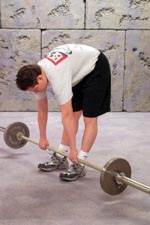 |
|
|
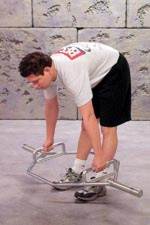 |
|
Figure One |
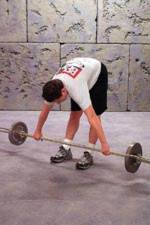 |
|
Figure Two |
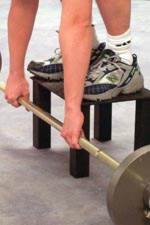 |
|
Figure Three |
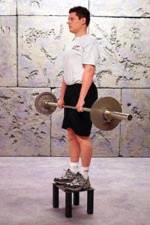 |
|
Figure Four |
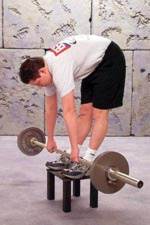 |
|
Figure Five |
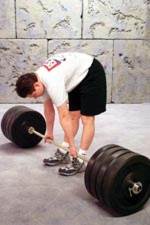 |
|
Figure Six |
 |
|
Figure Seven |